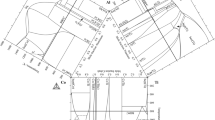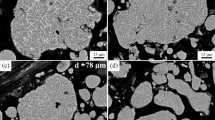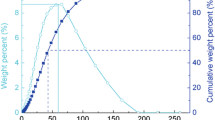Abstract
Powders of Al68.5Ni31.5 were produced using the impulse atomization technique. The molten droplets were cooled in-flight by the stagnant helium or nitrogen in the atomizing chamber, and the resulting powders were sieved into different size ranges. Scanning electron microscopy, X-ray diffraction, and neutron diffraction were used in order to study the microstructure and to quantify the phase fractions in the samples. The computer software GSAS was used to calculate the weight fraction of the existing phases, namely Al3Ni2, Al3Ni, and Al, by the profile refinement method. X-ray micro-tomography and optical microscopy were used to study the porosity formation inside the particles. It was found that for particles having sizes decreasing from 925 to 256 μm (increasing cooling rate), the weight fraction of Al3Ni and eutectic Al decreases while that of Al3Ni2 increases. Furthermore, the droplets formed at higher cooling rates yielded a lower volume fraction of porosity.










Similar content being viewed by others
References
Sumida M (2003) J Alloy Compd 349(1–2):302
Liu Y, Lan F, Yang G, Zhou Y (2004) J Cryst Growth 271(1–2):313
Devred F, Gieske AH, Adkins N, Dahlborg U, Bao CM, Calvo-Dahlborg M, Bakker JW, Nieuwenhuys BE (2009) Appl Catal A Gen 356(2):154
Patchett JA, Abbaschian GJ (1986) In: Mehrabian R, Parrish PA (eds) Proceeding of the fourth conference on rapid solidification processing: principles and technologies. University of California, Santa Barbara, CA, USA
Bao CM, Dahlborga U, Adkinsb N, Calvo-Dahlborg M (2009) J Alloy Compd 481:199
Tourret D, Gandin Ch-A (2009) Acta Mater 57:2066
Siquieri R, Doernberg E, Emmerich H, Schmid-Fetzer R (2009) J Phys 21:464112 (6 pp)
Henein H (2002) Mater Sci Eng A 326(1):92
Wiskel JB, Henein H, Maire E (2002) Canadian Metall Q 41(1):97
Nash P, Singleton MF, Murray JL (1991) Phase diagrams of binary nickel alloys. ASM, Materials Park, OH, p 3
Standard test methods for metal powders and powder metallurgy products, Metal Powder Industries Federation, Princeton, NJ (1993)
Von Dreele RB (1994) Neutron diffraction in materials science and technology: a comprehensive treatment, vol 2B. Wiley–VCHl, New York, NY
Johansson J, Ilbagi A, Thornton D, Henein H (2010) Processing 3D data sets from X-ray tomography of impulse atomized metal particles. TMS Annual Meeting, Seattle, WA, USA
Jones H (1983) Rapid solidification of metals and alloys. The Institution of Metallurgists, London, p 40
Kurz W, Fisher DJ (1989) Fundamentals of solidification. Transaction Technical Publication, Switzerland, p 88
Rohsenow WM, Hartnett JP, Cho YI (1998) Handbook of heat transfer, 3rd edn. McGraw-Hill, New York
Kerr HW, Cisse J, Bolling GF (1974) Acta Metall 22:677
St John DH, Hogan LM (1987) Acta Metall 35(1):171
Kasperovich G, Volmann T, Ratke L, Herlach D (2008) Metall Mater Trans A 39(5):1183
Sarreal J, Abbaschian G (1986) Metall Mater Trans A 17(11):2063
Prasad A (2006) Microsegregation studies of rapidly solidified binary Al–Cu alloys. PhD Thesis, University of Alberta
Buchoud V, Schmidt R-R, Henein H, Malahof D, Gandin C-A, Lesoult G, Uhlenwinkle V (2010) Canadian Metall Q 49(3):275
Han Q (2008) Shrinkage porosity and gas porosity, casting, vol 15, ASM handbook. ASM International, Ohio, p 370
Acknowledgements
This research was supported by Canadian Space Agency (CSA) and by Natural Sciences and Engineering Research Council of Canada (NSERC). The authors would like to thank Atomic Energy Canada Limited (AECL), Chalk River, and Oak Ridge National Laboratory (ORNL), TN, USA, for their support in conducting the neutron diffraction experiments. We would also like to acknowledge The Swiss Light Source, Paul Scherrer Institut, Villigen, Switzerland, and European Synchrotron Radiation Facility (ESRF) in Grenoble, France for beam time. The authors are grateful to Guillaume Reinhart for conducting micro-tomography experiments. We are also thankful to Ian Swainson, Ulf Dahlborg and Monique Calvo-Dahlborg for their assistance in data analysis.
Author information
Authors and Affiliations
Corresponding author
Rights and permissions
About this article
Cite this article
Ilbagi, A., Henein, H. & Phillion, A.B. Phase quantification of impulse atomized Al68.5Ni31.5 alloy. J Mater Sci 46, 6235–6242 (2011). https://doi.org/10.1007/s10853-010-4972-8
Received:
Accepted:
Published:
Issue Date:
DOI: https://doi.org/10.1007/s10853-010-4972-8




